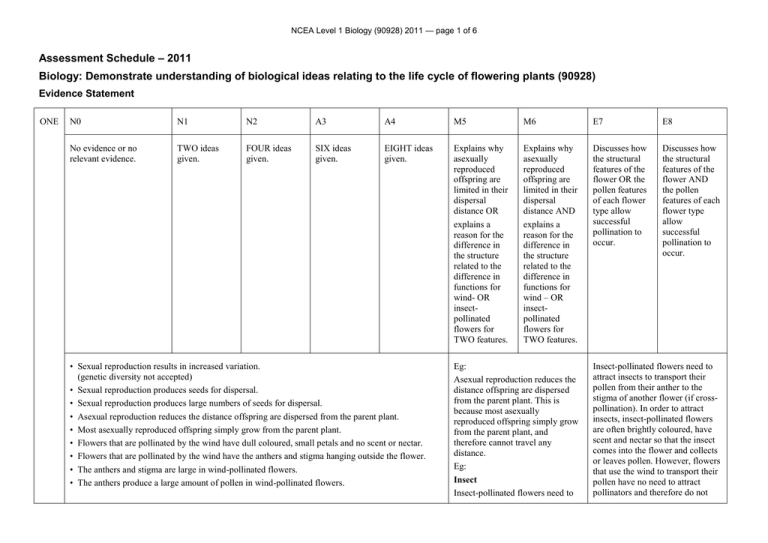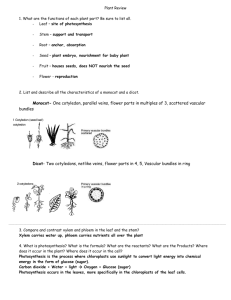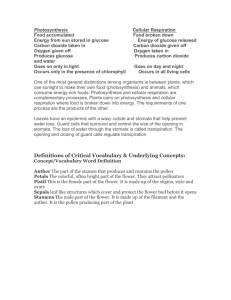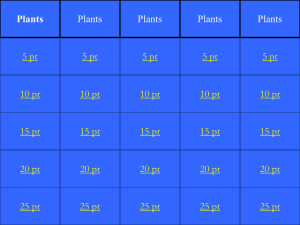– 2011 Assessment Schedule
advertisement

NCEA Level 1 Biology (90928) 2011 — page 1 of 6 Assessment Schedule – 2011 Biology: Demonstrate understanding of biological ideas relating to the life cycle of flowering plants (90928) Evidence Statement ONE N0 N1 N2 A3 A4 M5 M6 E7 E8 No evidence or no relevant evidence. TWO ideas given. FOUR ideas given. SIX ideas given. EIGHT ideas given. Explains why asexually reproduced offspring are limited in their dispersal distance OR explains a reason for the difference in the structure related to the difference in functions for wind- OR insectpollinated flowers for TWO features. Explains why asexually reproduced offspring are limited in their dispersal distance AND explains a reason for the difference in the structure related to the difference in functions for wind – OR insectpollinated flowers for TWO features. Discusses how the structural features of the flower OR the pollen features of each flower type allow successful pollination to occur. Discusses how the structural features of the flower AND the pollen features of each flower type allow successful pollination to occur. • Sexual reproduction results in increased variation. (genetic diversity not accepted) • Sexual reproduction produces seeds for dispersal. • Sexual reproduction produces large numbers of seeds for dispersal. • Asexual reproduction reduces the distance offspring are dispersed from the parent plant. • Most asexually reproduced offspring simply grow from the parent plant. • Flowers that are pollinated by the wind have dull coloured, small petals and no scent or nectar. • Flowers that are pollinated by the wind have the anthers and stigma hanging outside the flower. • The anthers and stigma are large in wind-pollinated flowers. • The anthers produce a large amount of pollen in wind-pollinated flowers. Eg: Asexual reproduction reduces the distance offspring are dispersed from the parent plant. This is because most asexually reproduced offspring simply grow from the parent plant, and therefore cannot travel any distance. Eg: Insect Insect-pollinated flowers need to Insect-pollinated flowers need to attract insects to transport their pollen from their anther to the stigma of another flower (if crosspollination). In order to attract insects, insect-pollinated flowers are often brightly coloured, have scent and nectar so that the insect comes into the flower and collects or leaves pollen. However, flowers that use the wind to transport their pollen have no need to attract pollinators and therefore do not NCEA Level 1 Biology (90928) 2011 — page 2 of 6 • Flowers that are pollinated by insects are bright coloured. • Flowers that are pollinated by insects are sweet smelling. • Flowers that are pollinated by insects produce nectar. • The anthers and stigma are located within the flower of insect-pollinated flowers. (Must have both anthers and stigmas when describing the features for the mark.) attract insects to transport their pollen from their anther to the stigma of another flower (if crosspollination). In order to attract insects, insect-pollinated flowers are often brightly coloured, have scent and nectar, so the insect comes into the flower and collects or receives the pollen. OR The anthers of insect-pollinated flowers produce large pollen grains with a rough surface. This helps them stick to the insect’s body as it brushes against the anther and remain there until it is brushed off on a stigma. OR The anthers and stigmas of insectpollinated flowers are usually found inside the petals. This helps to ensure that as the insect enters the flower in search of nectar, or enticed by the scent, it will brush against the anther and collect pollen. OR Wind The pollen produced by windpollinated flowers is usually small, light and smooth, and many grains are produced. This is so they are more easily carried on the wind and are more likely to land on a stigma. OR In wind-pollinated flowers the anther and stigma tend to be large and hang outside the small petals. generally have brightly coloured petals, scent or nectar, but rather, are small and often green. OR The anther of insect-pollinated flowers produces large pollen grains with a rough surface. This helps them stick to the insect’s body as it brushes against the anther and remain there until it is brushed off on a stigma. The pollen produced by windpollinated flowers is different. The grains are usually small, light and smooth and many are produced. This is so they are more easily carried on the wind, and are more likely to land on a stigma. OR The anthers and stigmas of insectpollinated flowers are usually found inside the petals. This helps to ensure that as the insect enters the flower in search of nectar, or enticed by the scent, it will brush against the anther and collect pollen and likewise brush against the stigma and deposit pollen. However, in wind-pollinated flowers, the anther and stigma tend to be large and hang outside the small petals. This ensures that both are more exposed to the wind to ensure pollen is collected from the anther, and will land on the stigma of another flower. Must be linked and shows a comparison For pollen – must link texture to NCEA Level 1 Biology (90928) 2011 — page 3 of 6 This ensures that both are more exposed to the wind to ensure pollen is collected from the anther and will land on the stigma of another flower. property. They are rough and sticky and attaches to the insects body as it brushes past the anther. For 8 – candidates must: Have linked explanations for flower reproductive structures: Position and how these aid cross pollination AND linked explanations comparing the features of both pollen in wind and insect pollenated plants. If candidates use feathery they must qualify what they mean by feathery for the excellent mark. Eg the stigma is feathery and has a larger surface area increasing its’ ability to catch pollen. NCEA Level 1 Biology (90928) 2011 — page 4 of 6 TWO N0 N1 N2 A3 A4 M5 M6 E7 E8 No evidence or no relevant evidence. ONE idea given. TWO ideas given. THREE ideas given. FOUR ideas given. Describes process of photosynthesis and explains how ONE part of the plant is involved in photosynthesis. Describes process of photosynthesis and explains how TWO parts of the plant are involved in photosynthesis. Describes process of photosynthesis AND discusses how EITHER the raw materials OR the parts of the plant allow photosynthesis to occur. Describes process of photosynthesis AND discusses how BOTH the raw materials AND the parts of the plant allow photosynthesis to occur. • The process of photosynthesis is the way in which plants use water and carbon dioxide, in the presence of chlorophyll and light energy, to make glucose (sugar) and oxygen. • The main parts of a plant involved in photosynthesis are the leaf, and the chloroplasts in the plant cells. • The leaf captures the light energy./absorb • Chloroplasts contain the chlorophyll. • Chloroplasts / Chlorophyll are the place where photosynthesis occurs. • The stomata allow carbon dioxide into the leaf. • Stomata are arranged at the bottom of the leaf to prevent evaporation of water. • Vascular bundle / Xylem tubes transport water from the roots to the leaves • Waxy cuticle allows light through/prevents water from evaporating before it can be used for photosynthesis. • Size/orientation of leaves (larger leaves in low light conditions /smaller leaves in high light conditions but more of them / leaves facing the sun) • Spongy mesophyll has intra-cellular spaces to allow for carbon dioxide to diffuse into the leaf faster. Root hairs gain water from the soil by osmosis Accept starch in place of glucose. Eg: The process of photosynthesis is the way in which plants use water and carbon dioxide, in the presence of chlorophyll and light energy, to make glucose (sugar) and oxygen. The main parts of the plant involved in photosynthesis are the leaf and the chloroplasts in the plant cells. The leaf is broad and flat to capture the light energy. The chloroplasts contain the chlorophyll, and are the place where photosynthesis occurs. There are many chloroplasts in the leaf cells close to the surface of the leaf to allow light energy to be absorbed. Accept more / higher amount of chlorophyll in cells in the leaf making photosynthesis more efficient Accept starch in place of glucose. Root hairs increase the surface area of the root gaining water from the soil by osmosis. The water then diffuses towards Gives reasons for how the parts of the plant are involved in using water, carbon dioxide, chlorophyll and light to carry out the process of photosynthesis. Discussion with how materials, parts and process linked. Eg: The process of photosynthesis is the way in which plants use water and carbon dioxide, in the presence of chlorophyll and light energy, to make glucose (sugar) and oxygen. Plants absorb as much light energy as possible through the leaves that are often broad and flat to allow for this. Once enough light energy has been absorbed into the chlorophyll inside the numerous chloroplasts in the plant cells, carbon dioxide has diffused into the leaf through the numerous stomata on the underside of the leaf, and water is received via the xylem from the root hairs of the plant, the chloroplasts can carry out the NCEA Level 1 Biology (90928) 2011 — page 5 of 6 the xylem vascular bundle where it is transported up towards the leaves, where it will be used by the cells in the leaf for photosynthesis. Look for adaptations such as: Increase of chlorophyll/chloroplasts to increase use of light energy and makes photosynthesis more efficient. Smaller leaves in canopy trees but more leaves per unit area increases surface area and exposure to light. Leaves following the direction of the sun. Larger leaves for shade tolerant plants. THREE complex chemical process of photosynthesis. This results in the production of an energy-rich substance called glucose and oxygen gas. N0 N1 N2 A3 A4 M5 M6 E7 E8 No evidence or no relevant evidence. ONE idea given. TWO ideas given. THREE ideas given. FOUR ideas given. Explains the function of a seed component OR one aspect of the graph (live or dry mass). Explains the function of a seed component AND one aspect of the graph (live or dry mass). Discusses the mass changes to either live mass OR dry mass, relating it to germination. Discusses the mass changes to both live mass AND dry mass, relating it to germination. • A main environmental condition is water or moisture (to rehydrate the seed). • A main environmental condition is warm temperatures (to increase metabolic activity). Accept suitable temperature for • A main environmental condition is oxygen. Structures of the seed include: • tough testa/Protection • endosperm or cotyledons:starch store nutrients • lack of water, state of dehydration • micropyle. Allows oxygen in for respiration / water in to activate metabolic enzymes(respiration) • The live mass increases throughout the germination process. Eg: The testa is the tough, impermeable layer around the seed. This protects it while it is dormant, and stops germination unless enough water is present. The endosperm and cotyledons have enough starch stored, so that the seeds can metabolise it slowly during dormancy for several years and not lose viability. As a seed ripens, it dehydrates itself and the metabolic activity slows right down. The enzyme necessary for germination requires water. Oxygen can enter through the micropyle During germination, the mass of living tissue in the seed (live mass) increases because the seed is taking up water. This water is needed initially to rehydrate the seed, so there is a big jump in live mass initially. As the seedling germinates and starts to grow, water is contained within its new cells, and the live mass continues to increase. The dry mass decreases as the energy reserves are being used up by respiration. Once the plumule reaches the surface of the soil, the seedling is exposed to light and NCEA Level 1 Biology (90928) 2011 — page 6 of 6 • The dry mass initially decreases. • The dry mass increases after day 10. for cell respiration (metabolism). During germination, the mass of living tissue in the seed (live mass) increases because the seed is taking up water. For the live mass the candidate must show initial increase linking to increase in water absorption in the seed and the increase in growth linked to photosynthesis after day 10 The dry mass decreases as the energy reserves in the cotyledons are being used up by respiration. And increase due to photosynthesis. photosynthesis is able to begin. At this point the dry mass starts to increase as the plant is no longer dependent upon food stored in the seed for energy. Judgement Statement Score range Not Achieved Achievement Achievement with Merit Achievement with Excellence 0–8 9 – 13 14 – 18 19 – 24






